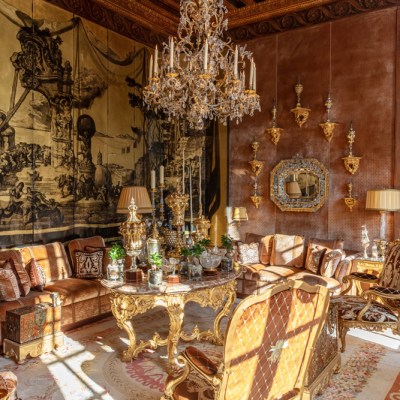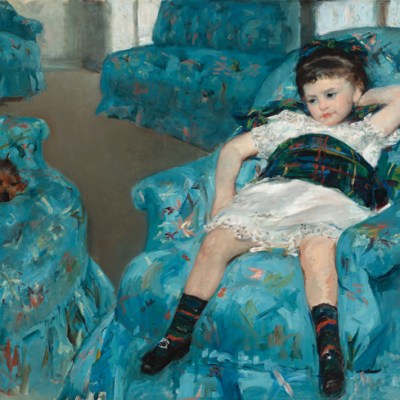For Paul Gauguin, Mary Cassatt had ‘as much charm, and more power’ than any other woman artist of her day. He even put his money where his mouth was; after viewing the painting of a young lady in an opera box that sent him into these superlatives, he purchased another from the same series in 1884. While impecuniousness forced him to sell off most of his collection, this was one he held onto – it remained in his hands at his death, recorded afterwards in the collection of his brother-in-law Edvard Brandes.
It’s easy to see what attracted him. Young Lady in a Loge Gazing to the Right is a work of shimmering textures and rippling curves. Metallic paint combines with watercolour, pastel, gouache and charcoal to give a finish that is in some passages rich and lush, in others rough and abraded. The woman’s face is cast in shadow, and there is something mournful in her gaze – but the light catches her hair and brings it to dazzling life.
Young Lady in a Loge Gazing to the Right (c. 1878–79), Mary Cassatt. Christie’s New York (est. $3m–$5m)

In the home of the painting’s most recent owners, Ann and Gordon Getty, it was hung above a chest of drawers, on which was perched a fan rather like the one the figure holds before her – splayed out, as though bodied forth from the canvas. It’s a tiny detail – one that visitors to the Gettys may have found easy to miss, amid the opulence of their home in San Francisco. But it’s precisely this eye for connections that makes the collection offered by Christie’s in New York this week so unusual.
Other collectors with the financial clout of the Gettys may, for instance, have been content simply with snapping up works by the major names of Impressionism and Post-Impressionism; their focus was more rigorous, and their paintings of this era home in beyond the movements at large to a particular moment in the late 1870s and early 1880s, when painters like Cassatt and Edgar Degas were flushed with successful showings at the Fourth Impressionist Exhibition of 1879. Alongside the Cassatt, the Gettys had an early still life of flowers strewn haphazardly across a pile of books on a table by Gauguin of 1882 – a decade before his travels among Breton farmers and Pacific Islanders (est. $200,000–$400,000) and a flower study by Cézanne that likewise long predates his obsession with the Mont Sainte-Victoire, and suggests the influence of Manet’s late floral paintings (est. $500,000–$700,000). (It is perhaps less redolent of the latter’s exuberant portrait of ‘Bob’, the pet mutt of his patron Jean-Baptiste Fauré, which is also on offer here; est. $400,000–$600,000; price realised: $1.4m).
Flowers and Books (1882), Paul Gauguin. Christie’s New York (est. $200,000–$400,000)

There is a jewel-like Degas pastels of ballet-dancers from around the same time (est. $1.2m–$1.8m; price realised: $3.1m), and a wintry scene by Monet of 1879 that serves as a reminder, if one were needed, of why he is one of the great painters of what it is like to feel cold (est. $2.5m–$2.5m; price realised: $3.2m). The Cassatt leads this pack of Impressionists with an estimate of $3m–$5m; perhaps it might exceed expectations to break the artist’s record of $6.2m, set at Christie’s New York back in 1998, which would be all the more remarkable given that the Young Lady is primarily painted in pastel. (Update, 21 October: the painting was bought by the PolaMuseum of Art in Hake, Japan, for a record $7.5m, on the first of the four evening sales.)
Venice, the Grand Canal looking East with Santa Maria della Salute (c. 1750), Canaletto. Christie’s New York ($6m–$10m)

French painting was just the tip of the iceberg for the Gettys. Ann, an anthropologist by training, and Gordon, a composer and the fourth son of J. Paul Getty, who took control of the Getty Trust on his father’s death in 1976, were inspired above all by the meeting point of global cultures. Exemplifying this is a remarkable Canaletto in the collection depicting the Santa Maria della Salute, which faces east, in the direction of the ships that arrived in Venice bearing loads of porcelain, lacquerware and other treasures; with an estimate of $6m–$10m, it is expected to be the top lot. (Update, 21 October: the work was acquired by the Fine Arts Museum of San Francisco in a private deal brokered before the sale.)
Their home itself was a kind of bricolage – French silver, Chinese enamels, textiles from Asia and Europe, English furniture all combined – and their heart was set racing above all when such a blend of cultures occurred within a single object: they had a particular love of lacquered furniture, produced in England in the 17th-century to mimic the examples of China and Japan. Not always convincingly, it must be said – and while the Gettys were surely aware of this, the fact that they surrounded themselves with so many visions of the Far East as seen through European eyes does mark out the collection as belonging to a particular time and place.
The dining room at Ann and Gordon Getty’s residence in San Francisco. Photo: © Visko Hatfield for Christie’s, 2022

With more than 1,500 lots, the Getty sale kicks off an autumn season in New York that brings a number of other single-owner sales – including that of Microsoft co-founder Paul Allen at Christie’s, and of the lawyer and philanthropist David Solinger at Sotheby’s. Somewhere in the region of $180m is expected for the Gettys’ trove – a tidy endowment for the Ann and Gordon Getty Foundation for the Arts, for which proceeds have been earmarked.
This article was updated on 21 October to reflect the results of the first round of the sale, held on the evening of 20 October.



